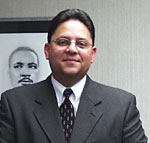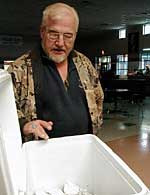Accountability in the urban justice system
By Elizabeth Stawicki
Minnesota Public Radio
November 2001
|
| RealAudio |
An overview | Accountability in the justice system | American Indians and the rural justice system | The new disparities | Driving while black
Studies show African-Americans and other people of color are in Minnesota's criminal justice system at a rate far greater than their presence in the population. That disparity has grown despite years of studies. No one seems to know why Minnesota's predominantly white population turns overwhelmingly non-white inside the state's prison gates. Some blame police practices, such as racial profiling, for bringing more people of color into the court system. But in the end, judges have the responsibility for sending people to jail.
| |
|
|
|
||
A forthcoming study by the Minneapolis-based Council on Crime and Justice, shows the gap between blacks and whites widens further within the state's court system. For felonies, the disparity widens from point of arrest to sentencing.
Mark, 22, an African-American on probation for felony drug possession, says he's not surprised. He believes whites view African-Americans as more dangerous and that perception permeates the courts. As a result, people of color don't get breaks that whites do.
"They wouldn't have wanted that to go on my record because there would still be a chance for me to go back to school," he says. "Then when it was me, I'm already going to school, I'm already trying to turn my life around. It was just like, it's a one-way road for you, he'll be back."
Judges, court staff and prosecutors have suggested in the past, that police practices, such as racial profiling, overwhelm the courts with people of color. But in the end, it is the judges who've sent 21 people of color to prison for every white person.
"It's the single biggest failure of the justice system because I can't give you any defensible answer as to why we're continuing to have huge numbers of African-Americans, Hispanic or Native Americans in the justice system, and treated, at least on the surface, disproportionately harsh," says Hennepin County Chief Judge Kevin Burke.
Burke and the other judges consider themselves sensitive to race issues, but the racial disparity has worsened on their watch. That's leaving some of the best legal minds scratching their heads as to why. No one judge or prosecutor appears responsible.
| |
|
|
|
||
Hennepin County Chief Public Defender Leonardo Castro says these subtle biases add up and result in the high numbers of people of color in Minnesota's prisons.
"From the point where we create a law, to enforcing that law, from the arbitrary decisions that are made, the enforcement of those laws, and discretionary decisions," Castro says.
Here's one stop along the criminal justice continuum where judges have discretion. Today, Judge Richard Hopper hears the arraignment calendar in Hennepin County. It's a lighter morning than usual, only 90 cases. Judge Hopper must decide in a couple of minutes whether to release this woman charged with prostitution while she awaits her court date.
He has several options: he can keep her in jail, release her outright, or in an area where he has even greater discretion, release her conditionally. If she meets the conditions, she remains free. If not, she goes back to jail. At such moments, judges hedge their bets on whether a person will flee or commit another crime if released.
Hopper releases the woman, provided she gets in touch with a group to help her leave prostitution. She must also stay in touch with a probation officer. Should she fail to meet those conditions, the judge will order her back to jail to await trial.
The Council on Crime and Justice says early numbers from its study show people of color spend more time in jail before trial than whites arrested for the same crime, but it doesn't know why.
Hennepin County Chief Public Defender Leonardo Castro says judges use standards that value community roots when they decide who gets released before trial. For example, do you own a home; have a steady job, or have family in the area? That criteria is applied across the board to defendants of all races. But Castro says those values are based on the experiences of mostly white middle-class legislators and judges.
"If somebody is a new person to this country and maybe just started a job, we place a standard on that person of the person who grew up in this area, who has a job of 15 years, who's got family in the area," he says. "The standards that we place on some people are not fair."
| |
|
|
|
||
Judges can make as many as a dozen discretionary decisions in each criminal case. Some may appear insignificant on the surface, but they may further compound inequities in the justice system.
Tom Johnson of the Council on Crime and Justice says he'd like to analyze these decisions more thoroughly, but it in the end may not be possible.
"We haven't been able to pick up what happens by race to the point of sentencing. So there are lots of decisions that are getting made in between that could have racial implications that we simply haven't been able to track," Johnson says.
But Chief Judge Kevin Burke says the state doesn't need more statistics to identify what's already known. He takes the racial disparities personally and even suggests Hennepin may need a new chief judge. He says public officials need to take responsibility for the inequities in Minnesota's justice system.
"I don't believe that this state will make progress until the chief justices, the chief judges, the mayors, the speakers of the house, acknowledge that race is a key critical issue that this state needs to confront." Until then, "Minnesota is like the person who's chemically dependent, but won't acknowledge a problem," Burke says.
"We incarcerate more African-Americans per capita than Alabama," he says. "But the problem is: we end up basically saying they're racist; we stereotype people in the south as racist and we're not willing to accept for purposes of discussion, we have those same attitudes."
Acknowledging a problem may be doubly difficult for Minnesotans who have long viewed themselves as citizens of a state progressive on the issue of race. The same state that produced Hubert Humphrey, Roy Wilkins and other civil rights pioneers now leads the nation in its ratio of imprisoning people of color compared to whites.
Related Information
•Debate: Should felons vote? Civil rights groups across the nation are challenging laws that ban convicted felons from voting. They argue the laws are outdated, racist and dilute the voting strength of people of color.



